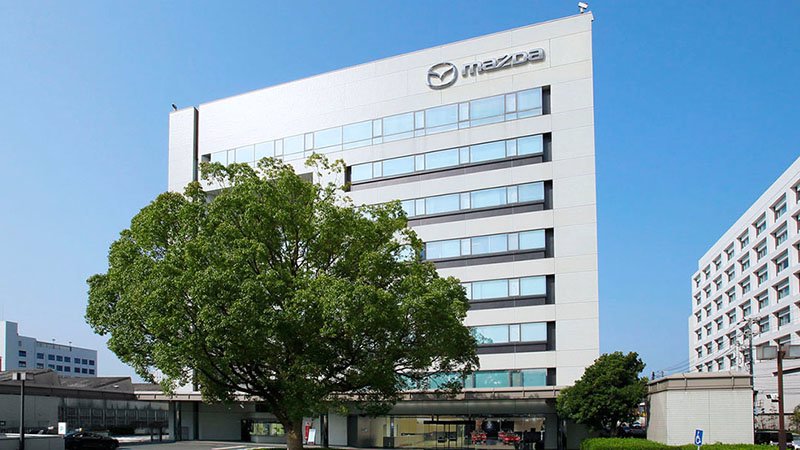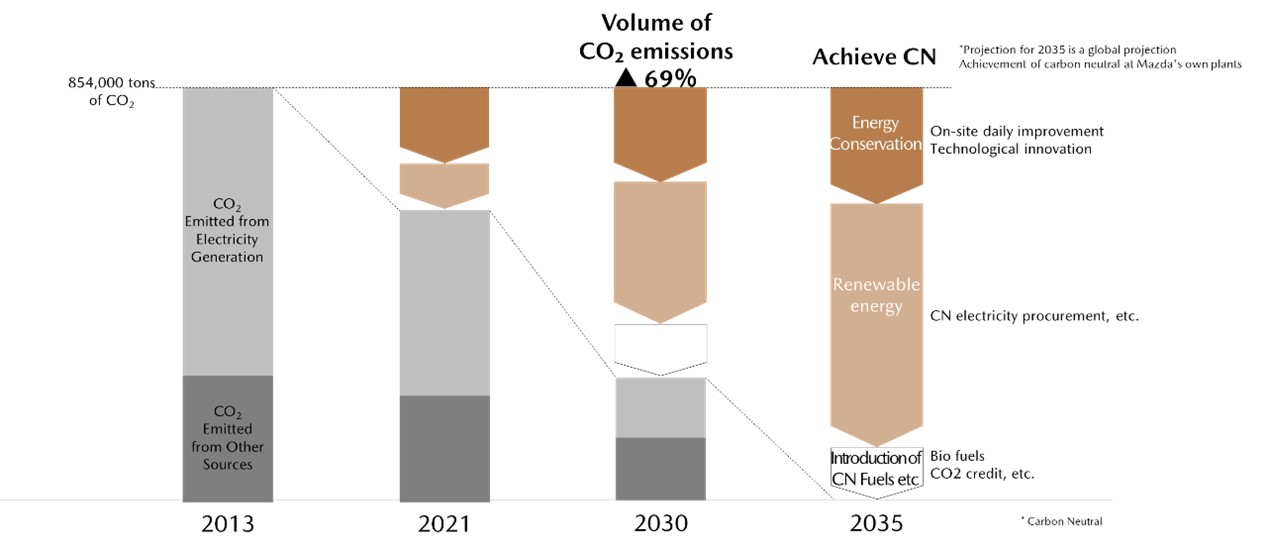Mazda specifies roadmap for carbon-neutral factories, setting mid-term targets for its domestic plants
Hiroshima / Leverkusen, 14/12/2023

- By FY2030, Mazda will reduce CO2 emissions in Japan by almost 70 percent
- By the same time, 75 percent of the power used will domestically be non-fossil fuel power
Renewing its commitment to making Mazda factories globally carbon neutral by 2035, the Mazda Motor Corporation today specified important milestones on its carbon-neutrality roadmap. By Fiscal Year (FY) 2030, Mazda will reduce the CO2 emissions at its factories and operational sites in Japan*1 by 69 percent compared to FY2013 levels. To date, Mazda facilities in Japan account for 75 percent of Mazda’s CO2 emissions. Reaching this target will therefore significantly reduce Mazda’s CO2 emissions in the medium term and have a strong effect on its ability to achieve carbon neutrality.

To achieve carbon neutrality at all factories globally by 2035, Mazda will be focusing on three pillars: energy conservation, shifting to renewable energy, and introducing carbon neutral fuels. Mazda announced first actions in all three areas that will be implemented domestically in the short term:
- Energy conservation
As a measure to support energy conservation, Mazda will be introducing Internal Carbon Pricing*2 as one of the capital investment criteria. As a result, investment decisions concerning Mazda facilities will consider the future price of carbon trading and prioritize investments that make a major contribution to CO2 emissions reduction. Mazda will continue working in all areas, including for example production and infrastructure, to improve the efficiency of its facilities and transform the technologies used in these areas.
- Shifting to renewable energy
Also, in Japan, Mazda will start switching the fuel used to supply the power generation facilities of MCM Energy Service Co., Ltd. (Hiroshima City, Hiroshima Prefecture), at Hiroshima plant Ujina District (Hiroshima City, Hiroshima Prefecture) from fossil fuels to liquid ammonia*3. The company will also be making use of a corporate Purchase Power Agreements (PPA)*4 signed with other local parties to increase the purchase of non-fossil fuel derived sustainable energy from power companies. As a result of these actions, Mazda plans to achieve a usage ratio for non-fossil fuel power of 75 percent by FY2030.
- Introducing carbon neutral fuels
To introduce carbon neutral fuels at its domestic facilities, Mazda will be switching the fuel used to power vehicles for transport within the company from diesel to a next-generation biofuel. In cases where generating power from alternative fuel sources proves difficult, Mazda will make use of the J-credit scheme*5 that promotes forestry preservation and re-forestry to absorb CO2 in the Chugoku region and other regions.
For this, also today, Mazda and Mitsui & Co., Ltd. have concluded a sales and purchase agreement covering J-Credits generated through appropriate forest management targeted toward the creation of a carbon-neutral society. The Credits are certified by the Japanese government under the J-Credit Scheme and will be generated through a joint project between Mitsui and a public interest incorporated association engaged in forest development in Okayama Prefecture.
Digital technologies employed in Mitsui’s Forests in Japan, including aerial surveying and satellite data, will be used to monitor forests to generate J-Credits. Some of the income provided by the Credits will be used through the joint project to develop and manage forests and enhance natural disaster preparedness. As the first company to use the Credits, Mazda will purchase credits based on the absorption of CO2 through forest conservation over an eight-year period from fiscal 2022 to fiscal 2029.
Commenting on this announcement, Takeshi Mukai, Director and Senior Managing Executive Officer (Oversight of Quality, Purchasing, Production, Business Logistics and Carbon Neutrality; Assistant to the Officer overseeing Cost Innovation), said:
"Mazda will move forward with carbon neutral initiatives in line with our plans to contribute to the reduction of CO2 emissions and the prevention of global warming across all of our processes including manufacturing transportation, usage, and recycling/disposal, as we believe that such efforts are a core responsibility of automotive manufacturers. Through these three pillars, Mazda is aiming to achieve carbon neutral at all of its global plants by 2035 and will attempt to achieve carbon neutral throughout the entire supply chain by 2050, contributing to the lasting coexistence with our planet."
For factories outside Japan, Mazda will be investigating optimal approaches for each region, using the carbon neutral initiatives established in Japan as a reference model.
Major Initiatives
|
|
Approach |
Major initiatives contributing to the achievement of our medium-term goal for FY2030 (Scope1-2*6) |
|
Energy Conservation |
|
|
|
Introduce |
|
|
|
Introduce |
|
|

